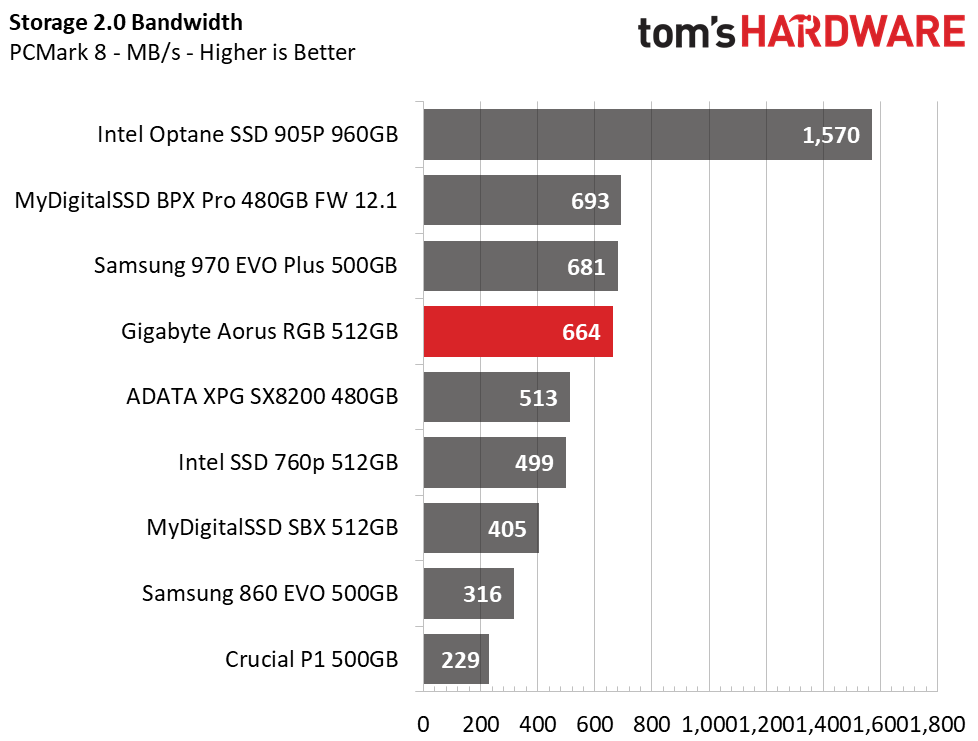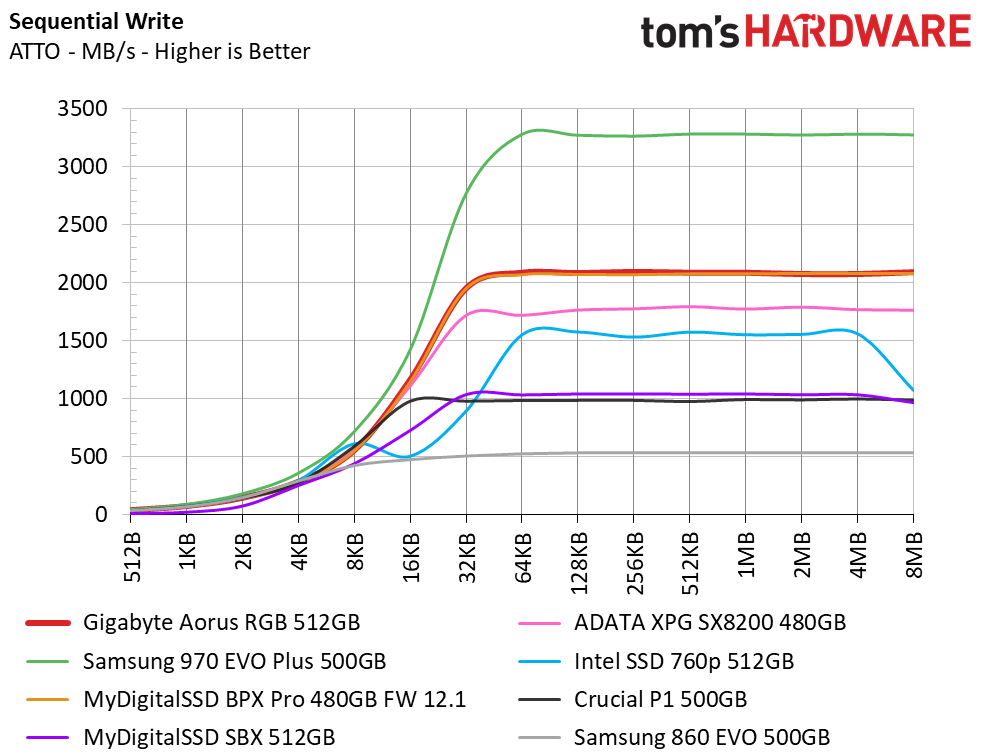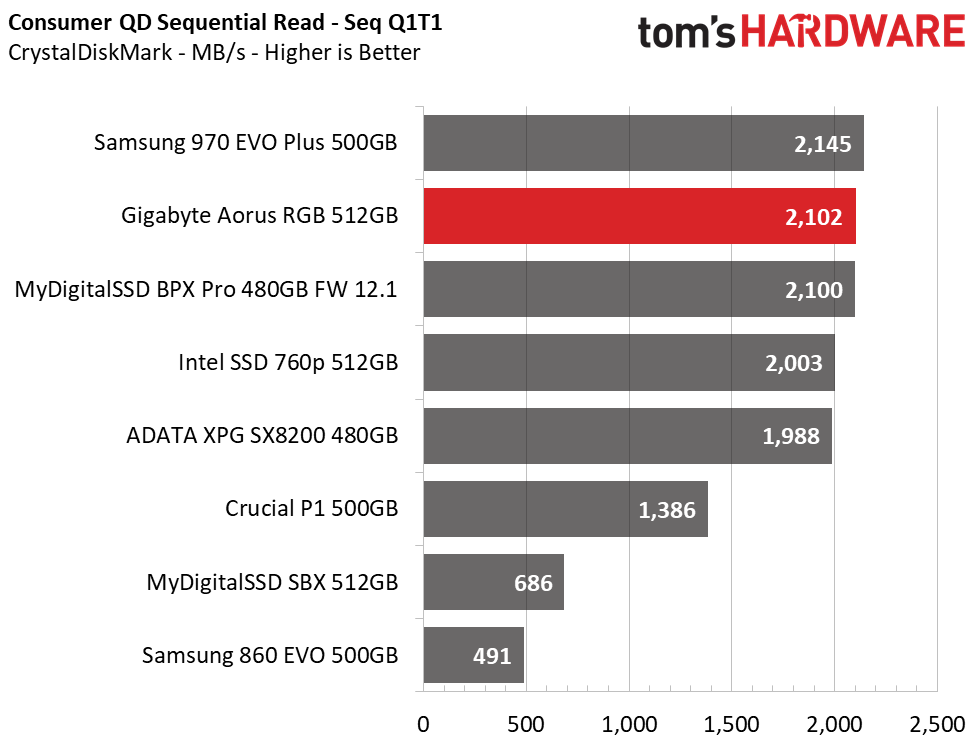Gigabyte Aorus RGB M.2 NVMe SSD Review: RGB Comes to M.2
Why you can trust Tom's Hardware
512GB Performance Results
Comparison Products
We selected a few popular SSDs to pit against the 512GB Gigabyte Aorus RGB. For this comparison, we included the SATA Samsung 860 EVO and PCIe Samsung 970 EVO Plus. We also added in Adata’s XPG SX8200, Intel’s 760p, and MyDigitalSSD’s BPX Pro with updated 12.1 firmware. Additionally, we threw the Crucial P1 and MyDigitalSSD SBX in to highlight the performance of lower-end alternatives.
Trace Testing – PCMark 8 Storage Test 2.0
PCMark 8 is a trace-based benchmark that uses Microsoft Office, Adobe Creative Suite, World of Warcraft, and Battlefield 3 to measure the performance of storage devices in real-world scenarios.


After being bombarded with PCMark 8’s Storage Test 2.0, the 512GB Gigabyte Aorus RGB ranked in fourth place. With a score of 5098 points and an average bandwidth of 644 MB/s, the Aorus RGB proves to be a speedy device that is quite competitive. It is, however, a bit slower than the MyDigitalSSD BPX Pro.
Game Scene Loading - Final Fantasy XIV
The Final Fantasy XIV StormBlood benchmark is a free real-world game benchmark that easily and accurately compares game load times without the inaccuracy of using a stopwatch.
The Aorus RGB is a gamer SSD by branding, and it loads games just as fast as most other SSDs. There is still some room for improvement here, though. While its total time of 22 seconds is faster than any hard drive, other NVMe SSDs are a second or two faster. The Samsung 860 EVO, a SATA SSD, even provided similar performance.
Transfer Rates – DiskBench
We use the DiskBench storage benchmarking tool to test file transfer performance with our own custom 50GB block of data. Our data set includes 31,227 files of various types, like pictures, PDFs, and videos. We copy the files to a new folder and then follow up with a read test of a newly-written 6 GB file.


The Aorus RGB provided an average bandwidth of 242 MB/s when we copied our 50GB test folder, which was good for sixth place. This is another instance where the Aorus lags slightly behind the BPX Pro, which was 22 MB/s faster during the test. Shifting gears to reading back the 6GB test file, the AORUS RGB trailed only the Samsung 970 EVO Plus.
Get Tom's Hardware's best news and in-depth reviews, straight to your inbox.
SYSmark 2014 SE
Like PCMark, SYSmark uses real applications to measure system performance. SYSmark takes things much further, however. It utilizes fourteen different applications to run real workloads with real data sets to measure how overall system performance impacts the user experience. BAPCo's SYSmark 2014 SE installs a full suite of applications for its tests, which includes Microsoft Office, Google Chrome, Corel WinZip, several Adobe software applications, and GIMP. That also makes it a great test to measure the amount of time it takes to install widely-used programs after you install a fresh operating system.


The installation of SYSmark went smoothly. The Aorus RGB completed the install in 14 minutes and 53 seconds, nearly matching Intel's Optane-powered 905P, which is quite the feat. After running the Aorus drive through its paces, SYSmark awarded it 1710 responsiveness points.
ATTO
ATTO is a simple and free application that SSD vendors commonly use to assign sequential performance specifications to their products. It also gives us insight into how the device handles different file sizes.


Overall, Gigabyte’s Aorus RGB mirrors the BPX Pro in the ATTO test. The Aorus drive hit 3.46 GB/s read and 2.1 GB/s write during the sequential workloads, ranking well above the lower-end NVMe SSDs like the Crucial P1 and MyDigitalSSD SBX.
CrystalDiskMark
CrystalDiskMark (CDM) is a simple and easy to use file size benchmarking tool.










At a QD (queue depth) of 32, the Aorus RGB comes in shy of its rated read performance of 3,480 MB/s but surpassed its write speed rating by nearly 100 MB/s, taking second place behind the Samsung 970 EVO Plus. At a QD of 1, which is the most important measurement to quantify "snappiness," the drive delivered up to 2.1/2 GB/s of read/write throughput.
Moving on to random performance, the Aorus RGB delivered an impressive 13,000 read IOPS and 43,000 write IOPS at QD1. Loading the drive with heavier workloads resulted in some of the highest results in the comparison pool. Here, it easily achieved its random write performance rating of 440,000 IOPS (and then some), as well as surpassing 300,000 read IOPS.
Sustained Sequential Write Performance
Official write specifications are only part of the performance picture. Most SSD makers implement an SLC cache buffer, which is a fast area of SLC-programmed flash that absorbs incoming data. Sustained write speeds can suffer tremendously once the workload spills outside of the SLC cache and into the "native" TLC or QLC flash. We hammer the SSDs with sequential writes for 15 minutes to measure both the size of the SLC buffer and performance after the buffer is saturated.



The Gigabyte Aorus ranks third in our write test. It features an SLC cache of about 14-15GB, which is actually a bit smaller than the MyDigitalSSD BPX Pro’s 24GB cache. This explains the differences in performance we see between the two drives. With a larger SLC cache, the MyDigitalSSD BPX Pro can handle a bit more bombardment with write workloads. Overall, the drives are quite close during the timed intervals. After the Aorus's SLC cache is exhausted, meaning this is the worst-case scenario, the SSD writes at about 600 MB/s.
Power Consumption
We use the Quarch HD Programmable Power Module to gain a deeper understanding of power characteristics. Idle power consumption is a very important aspect to consider, especially if you're looking for a new drive for your laptop. Some SSDs can consume watts of power at idle while better-suited ones sip just milliwatts. Average workload power consumption and max consumption are two other aspects of power consumption, but performance-per-watt is more important. A drive might consume more power during any given workload, but accomplishing a task faster allows the drive to drop into an idle state faster, which ultimately saves power.





| Gigabyte Aorus RGB M.2 SSD | Read Workload | Write Workload | Idle (ASPM) |
| Gigabyte Specification | 5.5W | 4.1W | 272mW |
We measured slightly lower power consumption than Gigabyte's official specification, but that could be due to the real-world testing method we use of copying a 50GB file. The drive hit a max of 4.55W and consumed an average of 2.74W during our test. The drive's efficiency score ranks sixth, which is a byproduct of its smaller SLC write cache.
At idle the Aorus consumed about a half a watt with ASPM (Active State Power Management) disabled and 122mW with the feature enabled, besting its official rating. We measured a ~70mW increase in power consumption due to the RGB lighting over the non-modified MyDigitalSSD BPX Pro. That small amount of power overhead won’t impact thermals much.
MORE: Best SSDs
MORE: How We Test HDDs And SSDs
MORE: All SSD Content

Sean is a Contributing Editor at Tom’s Hardware US, covering storage hardware.



